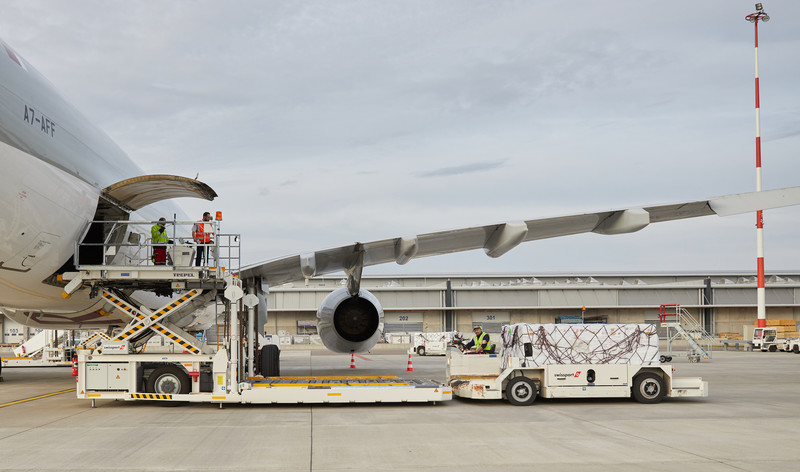Aviation
Airbus Launches OpenCargoLab with airfreight companies

In a bid to revolutionize the airfreight industry, Airbus has unveiled its latest initiative, the OpenCargoLab, in Toulouse, France.
With the goal of improving the whole airfreight ecosystem, this cooperative project unites a group of influential participants from several industries, such as airlines, handling, and logistics. A strong group of professionals from CHAMP Cargosystems, Fraport, KLM Cargo, Kuehne+Nagel, and Swissport make up the OpenCargoLab initiative. They each bring a distinct set of skills and insights to the table.
According to Airbus, this partnership will serve as a catalyst for the creation of resource- and digital-saving ideas that will promote more robust and effective airfreight procedures. In the midst of the vibrant IATA World Cargo Symposium in Hong Kong, Airbus announced the launch of OpenCargoLab, demonstrating their dedication to meeting the changing demands of the global freight business.
Airbus is putting itself in a position to benefit from the amazing 50% growth that is predicted for the airfreight business by 2042. focusing in particular on the Asia-Pacific area, which is known for its strong economic growth and rising need for contemporary airfreight solutions.
Over the following two decades, widebody freighter demand is expected to significantly increase, according to Airbus. Airbus hopes to attain more than 25% of the worldwide market for cargo aircraft in the above 40-ton segment, with an estimated 400 widebody freighters needed in the Asia-Pacific area alone.
Airbus intends to investigate a wide range of digital solutions, like as robotics and augmented reality, to improve risky cargo transportation and expedite data connectivity. An important part of this project is to have an A350F fuselage replica installed at the Cargo Test Center in Toulouse by the end of 2024, equipped with a sizable cargo door. Innovative airfreight solutions will be tested and refined out of this facility.

Aviation
Boeing, Antonov to Collaborate on Defense Projects

– MOU represents Boeing’s commitment to work with Ukrainian industry
– Includes exploring opportunities for collaborating on in-country support of Unmanned Aerial Systems
A Memorandum of Understanding was signed today by Boeing and Antonov Company to investigate potential collaboration on defense-related projects.
“We’re happy to keep collaborating with the Antonov Company to help Ukraine’s economic development and expansion,” stated Ted Colbert, CEO and president of Boeing Defence, Space, & Security.
Airbus and the Antonov An-225: The Best Partnership:Click here
“This agreement demonstrates our ongoing efforts to find more opportunities to work with Ukrainian industry, which was underscored by our signing of the Ukrainian Defence Industry Compact earlier this year.”
The areas of potential collaboration identified in the agreement consist of training, logistical support and overhaul services for tactical Unmanned Aerial Systems utilized by the Ukrainian Armed Forces, which includes the ScanEagle. In addition, the companies will also explore opportunities for Antonov to provide engineering support to Boeing.
The six largest cargo aircraft ever built in the aviation industry:Click here
“A strong, innovative, and efficient defense industry is key to sustainable economic development and national security, and we are extremely excited to collaborate with Boeing,” said Ievhen Gavrylov, CEO of Antonov Company.
This agreement brings a whole new level of opportunity to implement the latest and most effective solutions – in addition to the possibility of future projects with Boeing in the aerospace and defense industry.”
-

 Travel1 week ago
Travel1 week agoAir India to Expand US Operations with Three New Routes After a Decade
-

 Travel2 weeks ago
Travel2 weeks agoWhy We Should Avoid These Stamps in a Passport
-

 Airlines1 month ago
Airlines1 month agoInvestigations Reveal Fake Chinese Titanium in Boeing and Airbus Jets
-

 Tech4 weeks ago
Tech4 weeks agoChina’s CATL Plans 1,800-Mile Electric Plane Launch by 2027
-

 Airport3 days ago
Airport3 days agoTop 10 Largest Airports in the World by Size
-

 Aerospace4 weeks ago
Aerospace4 weeks agoChina’s Fighter Jets Turn Wings into Autonomous Drones
-

 Airlines4 days ago
Airlines4 days agoAir India Rolls Out A350s for Delhi-New York JFK and Newark Routes
-

 Defence3 weeks ago
Defence3 weeks agoBoeing Enhances Chinook with New Engines and Block II Upgrades at $96 Million







